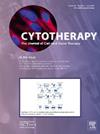Advancing Allogenic Cell Therapy with Automated iPSC Processing and Engineering: Benefits of a Closed Modular Approach.
IF 3.2
3区 医学
Q2 BIOTECHNOLOGY & APPLIED MICROBIOLOGY
引用次数: 0
Abstract
Background & Aim
Induced pluripotent stem cell (iPSC)-derived natural killer (iNK) cells have emerged as a promising platform for next-generation immunotherapy, offering a homogeneous, scalable and versatile approach for consistent large-scale manufacturing of off the shelf allogeneic therapies. This approach involves multiple steps including iPSC culturing and banking followed by gene editing and differentiation to tumor specific iNK cells to enhance cytotoxicity and tumor-targeting specificity, while minimizing risks of graft-versus-host disease. Building closed modular automated workflows will help minimize risks associated with manual processes associated with these methods. Through this work we built closed automated cell harvest, gene delivery and editing protocols that can enable iNK-based cell therapy manufacturing.
Methodology
In our current workflow, we cultured and expanded iPSCs up to a billion cells in a 10-layer cell factory system for master cell bank preparation. iPSC manual process and harvest in 10-layer cell factory system is very labor intensive and prone to contamination. Utilizing CTS Rotea counterflow centrifugation system minimized human intervention at multiple stages, including removal of media, washing of cells, addition of cell detachment media, collecting, concentrating iPSCs and delivering cells to collecting bags. Using this protocol, we processed the harvesting of entire iPSC culture in 10-layer cell factory system in a single batch to create a master bank for cell therapy development. We then successfully used these iPSC banks and carried out CRISPR-based non-viral gene editing using Neon NxT or CTS Xenon closed automated electroporation system for gene delivery, GMP grade CTS™ StemFlex media and high fidelity CRISPR-Cas9 system.
Results
The iPSCs processed using this method retain pluripotency characteristics with good viability and expansion rate. The CRISPR-based non-viral gene editing results shows successful generation of engineered CAR-iPSC with reproducible KI efficiency of up to 15%. We established the optimal target gene and promoter combination to stabilize transgene expression during the differentiation of iPSCs to iNK cells.
Conclusion
With methods developed through this work, we successfully generated potent CAR iNK cells. Together the workflows described here utilizing the clean room compliant closed automated cell processing and gene delivery platforms and the GMP compatibility iPSC and NK media systems enable clinical scale iNK cell therapy manufacturing.
推进同种异体细胞治疗与自动化iPSC处理和工程:封闭模块化方法的好处。
背景,诱导多能干细胞(iPSC)衍生的自然杀伤细胞(iNK)已经成为下一代免疫治疗的一个有前途的平台,为一致的大规模生产现成的同种异体疗法提供了一种均匀的、可扩展的和通用的方法。该方法涉及多个步骤,包括iPSC培养和储存,随后进行基因编辑和分化为肿瘤特异性iNK细胞,以增强细胞毒性和肿瘤靶向特异性,同时最大限度地降低移植物抗宿主病的风险。构建封闭的模块化自动化工作流将有助于最小化与这些方法相关的手动过程相关的风险。通过这项工作,我们建立了封闭的自动化细胞采集、基因传递和编辑协议,使基于墨水的细胞治疗制造成为可能。在我们目前的工作流程中,我们在10层细胞工厂系统中培养和扩增iPSCs至10亿个细胞,用于主细胞库的制备。在10层细胞工厂系统中,iPSC的人工处理和收获是非常劳动密集型的,容易受到污染。利用CTS Rotea逆流离心系统最大限度地减少了多个阶段的人为干预,包括培养基的去除、细胞的洗涤、细胞分离培养基的添加、iPSCs的收集、浓缩和将细胞运送到收集袋。使用该方案,我们在10层细胞工厂系统中单批处理整个iPSC培养物的收获,以创建细胞治疗开发的主库。然后,我们成功地使用这些iPSC库,并使用Neon NxT或CTS Xenon封闭自动电穿孔系统进行基于crispr的非病毒基因编辑,用于基因传递,GMP级CTS™StemFlex介质和高保真CRISPR-Cas9系统。结果该方法制备的多能干细胞具有良好的细胞活力和扩增率。基于crispr的非病毒基因编辑结果显示,成功生成了可重复KI效率高达15%的工程CAR-iPSC。我们建立了最佳的靶基因和启动子组合,以稳定iPSCs向iNK细胞分化过程中的转基因表达。结论通过本工作开发的方法,我们成功地生成了有效的CAR iNK细胞。这里描述的工作流程利用符合洁净室要求的封闭式自动化细胞处理和基因传递平台以及GMP兼容性的iPSC和NK介质系统,使临床规模的iNK细胞治疗制造成为可能。
本文章由计算机程序翻译,如有差异,请以英文原文为准。
求助全文
约1分钟内获得全文
求助全文
来源期刊

Cytotherapy
医学-生物工程与应用微生物
CiteScore
6.30
自引率
4.40%
发文量
683
审稿时长
49 days
期刊介绍:
The journal brings readers the latest developments in the fast moving field of cellular therapy in man. This includes cell therapy for cancer, immune disorders, inherited diseases, tissue repair and regenerative medicine. The journal covers the science, translational development and treatment with variety of cell types including hematopoietic stem cells, immune cells (dendritic cells, NK, cells, T cells, antigen presenting cells) mesenchymal stromal cells, adipose cells, nerve, muscle, vascular and endothelial cells, and induced pluripotential stem cells. We also welcome manuscripts on subcellular derivatives such as exosomes. A specific focus is on translational research that brings cell therapy to the clinic. Cytotherapy publishes original papers, reviews, position papers editorials, commentaries and letters to the editor. We welcome "Protocols in Cytotherapy" bringing standard operating procedure for production specific cell types for clinical use within the reach of the readership.
 求助内容:
求助内容: 应助结果提醒方式:
应助结果提醒方式:


